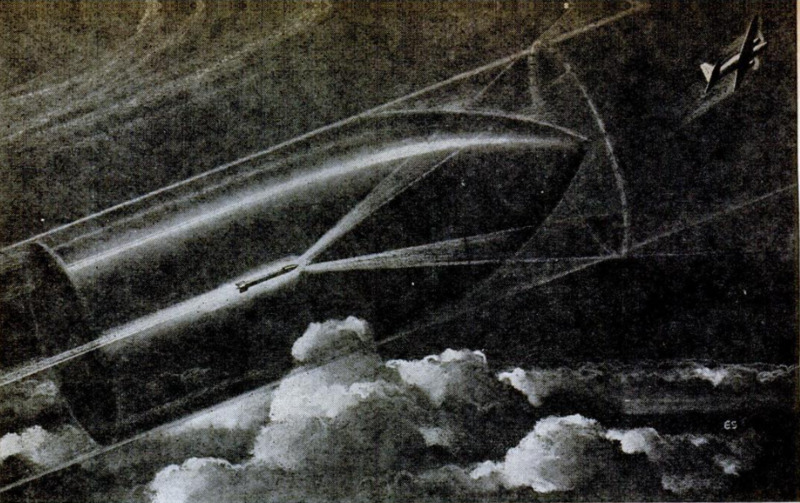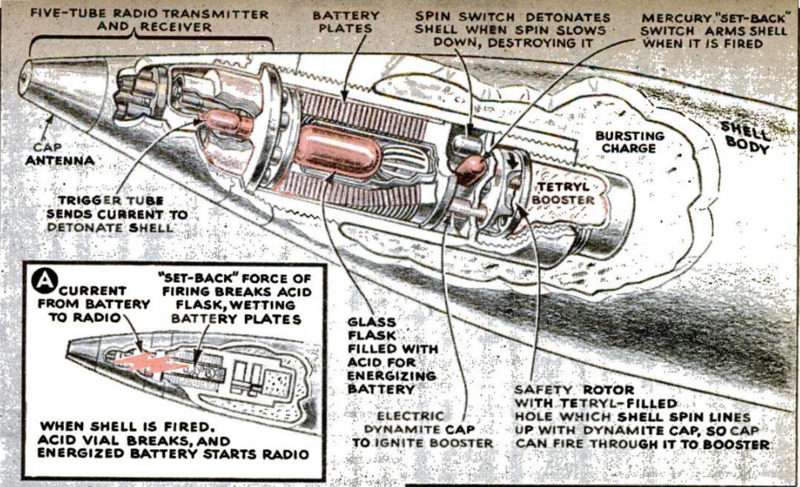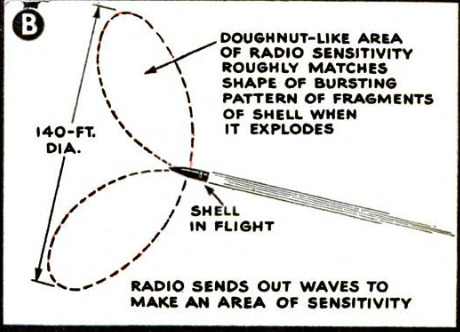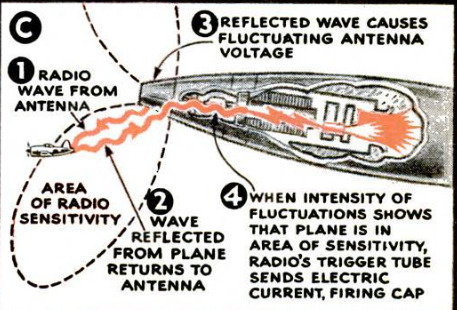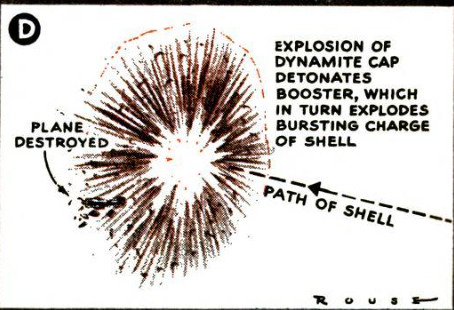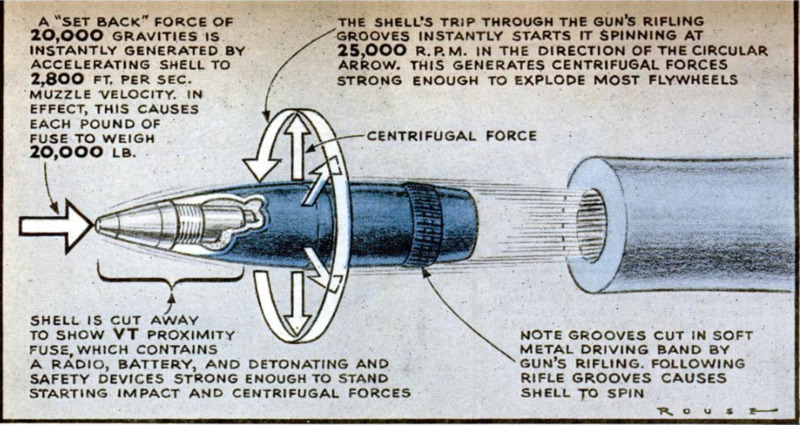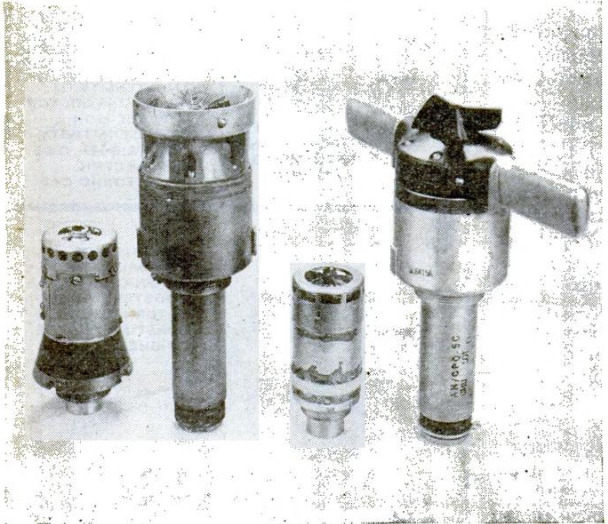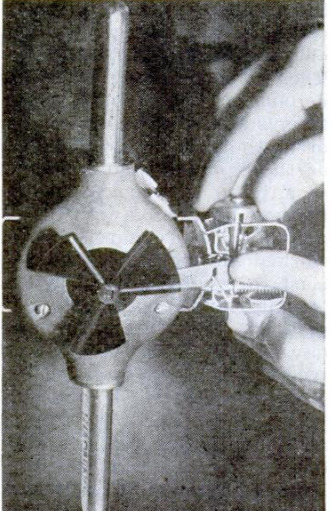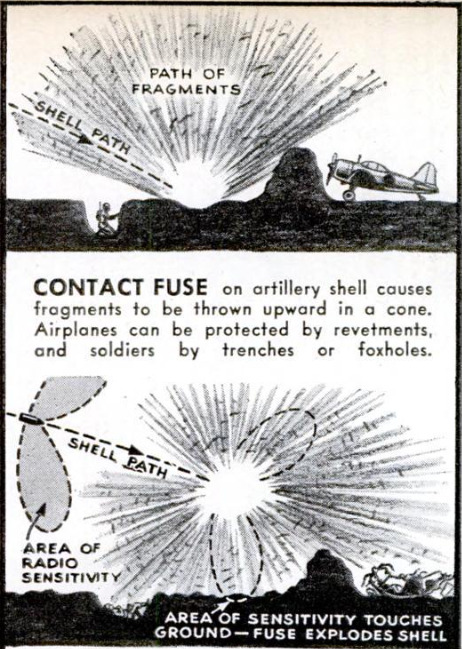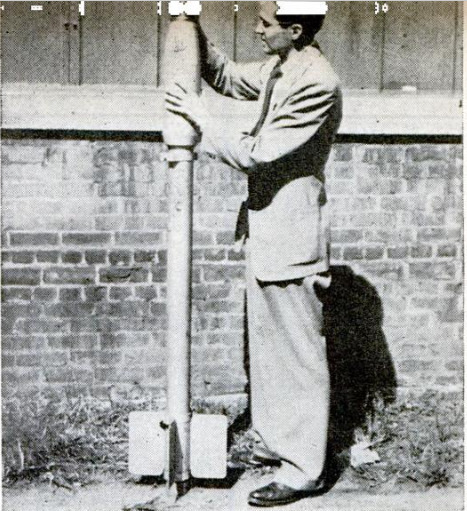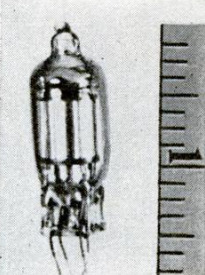-
Title (Dublin Core)
-
Shells hunt targets by radio
-
Article Title and/or Image Caption (Dublin Core)
-
Title: Shells hunt targets by radio
-
extracted text (Extract Text)
-
EARLY last December, every man on a
certain sector facing the Von Rundstedt
“bulge” in the Ardennes suddenly was thrust
into combat. Cooks, waiters, and truck
drivers were called on to participate in a
counterattack. The Germans had speared
into the American lines, and in doing so
had overrun an ammunition dump contain-
ing thousands of shells.
The counterattack succeeded. The dump
was recovered intact. And the Germans, all
unknowingly, sacrificed a chance to filch
from the United States the secret of one of
the three great scientific developments of
World War II. If, in retreating, they had
carted along with them just one of those
thousands of shells, they would have known
about the VT or “proximity” fuse, as closely
guarded against enemy intelligence as the
atomic bomb and radar.
So cautious had the Army and Navy been
about using the VT fuse, which explodes a
shell or a bomb merely by “looking at” a
target, that for almost two years after its
development the device had not been com-
mitted to battle use under any circum-
stances where the enemy could recover duds.
When the “Battle of the Bulge” developed,
it was decided to risk the fuse for the first
time under such conditions.
The VT (variable time) fuse is what
for ever since the explosive shell was in-
vented. When it passes within damaging
distance of a target, it explodes the pro-
jectile that carries it.
Until a sultry August day in 1940, when
the first handful of what was to become a
home army of 80,000 persons began work-
ing on VT's, only two ways of exploding a
bomb or a shell were known. It could be
set off either with a fuse that started a train
of detonation when it actually hit a target,
or with a fuse that was timed to start work-
ing a given number of seconds or fractions
of seconds after launching.
But time and impact fuses could not be
relied on to give a blanket of air bursts over
an enemy position at long or even medium
range. An enemy soldier hidden in a trench
or foxhole, or even lying flat on the ground,
had a fair chance of escaping an artillery
barrage unhurt. An impact-fused shell did
some damage, but when it hit it shattered
upward in an inverted cone. In antiaircraft
fire a direct hit on a plane at long range
was pure accident, so impact (or contact)
fuses could not be used. Time fuses caused
a great dispersion of bursts around a plane,
but only a small percentage of them were
close enough to do any damage.
All armies recognized the problem. Navies
recognized it even more. It had begun to
look as though the airplane, as a weapon
against ships, might never be coped with,
Despite our firepower, could we ever bring
our Navy to within effective distance of the
inner core of Jap resistance without losing a
prohibitive number of ships? If the Navy
found a weapon to solve its problem, it |
would be a two-edged sword—our air forces
could use it against the ground fire that
plagued their operations.
Every resource of research was applied to |
the problem. The detonation of an explosive |
container by a change in air pressure or by
changes in light intensity was considered.
Then someone thought of the possibility of
detonation by radio wave. A radio wave
travels at the speed of electricity and light, |
or at the rate of about 73; circuits of the
earth in one second. That would provide
sensitivity. Someone in Germany had |
thought of it, too. Captured German docu- |
ments showed that Nazi scientists had
worked on the radio-wave problem for at |
least 10 years and had given it up.
American and British scientists didn't |
give up. Less than three years from that
day in 1940, radio fuses were in production.
And this is their record in combat:
In the Battle of the Bulge, German
prisoners trudged dejectedly rearward mut- |
tering that this new and terrible weapon |
of the Americans ought to be outlawed. |
In the famous 80 days of V-1 bomb at-
tacks on London, the VT fuse became So
effective that defensive airplane attacks on
the robots were almost abandoned in favor
of straight antiaircraft fire. In the final
week of the buzz bombs, four out of every
five of the missiles shot at from the ground
were destroyed. No small measure of the
VT fuse’s success in antiaircraft operations
was due to its companion piece, the Ameri-
can electronic predictor (P.S.M., Sept. ‘44,
p. 115).
In ground operations, the VT swept Rhine
bridges clear of enemy troops like a broom,
yet left the bridges themselves intact. It
snapped Jap and German telephone com-
munications and opened paths through
barbed-wire entanglements as easily as
Moses parted the waters of the Red Sea.
In one instance, 60 howitzer shells, catch-
ing the enemy in the midst of a sneak attack
by rubber boat across a river, killed 702 men.
Allied fighter planes firing VT-fused
rockets averaged two hits out of every
three shots against enemy planes.
Tn one year, the Navy's statistics showed
that 51 percent of all enemy aircraft shot
down by antiaircraft five-inch guns had to
be credited to VT fuses. The remainder
were shot down by time fuses—but three
times as many time-fused as VT-fused
shells were used.
VT fuses gave the American First Army
a bag of 471 enemy planes in a single two-
week period. In the Pacific, trouble from
Jap antiaircraft fire was stopped regularly
with an antidote attack by aircraft carry-
ing VT-fused rockets and bombs.
. The gun firing VT-fused shells was, gen-
erally speaking, from 300 to 400 percent
more effective than one using time fuses.
Perhaps the most brilliant characteristic
of the proximity fuse used in bombs and
artillery shells is that it causes bursts to
conform to the terrain. An explosive charge
detonates as readily at a given distance
above a 2,000-foot mountain as it does above
a river valley.
“I think,” wrote a four-star general from
the European theater to Maj. Gen. T. H.
Campbell, Jr., of the Ordnance Department,
Washington, D. C., “that when all armies
get this shell, we will have to devise some
new method of warfare.”
The success of the VT fuse rests on a
well-known scientific principle known as the
“Doppler effect.” Happily enough, the minds
engaged in working on detonation by radio
wave knew it would function from a change
in the intensity of the reflected signal. In
other words, they knew a shell could be fired
on a horizontal path five feet off the ground
and that it wouldn't go off until the signal
rose in crescendo by increasing proximity
to the target.
You get “Doppler effect” when an air-
plane or a train roars by you. Astronomers
get it when planets approach and retreat
from the earth. The pitch of sound in the
train or the airplane rises as it approaches
you. The pitch drops as it goes by you. Stars
change color as they come toward the earth,
change again as they move away. All this is
due to the fact that a moving body, over-
taking the waves that it creates, piles up
those waves into shorter segments. Their
“pitch” rises.
The radio signal from the VT fuse builds
up “pitch” on the rebound, and the explosive
goes off. And to show how sensitive the
VT is, as compared with other devices pro-
posed, it will measure a distance of 70 feet
accurately, even though the waves energizing
it travel at more than 186,000 miles a second.
The VT fuse in the United States started
as an idea in 1940 at the Department of
Terrestrial Magnetism, Carnegie Institution,
in Washington. The Navy sponsored the re-
search on VT fuses for high-rotation pro-
jectiles such as
the shells used by big rifles. The Army
sponsored that on nonrotated and low-
rotated projectiles such aa bombs, rockets,
and mortar shells.
“The National Defense Research Commit-
tee, within the framework of the Office of
Scientific Research and Development, took
over the actual supervisory task. Special
scientific groups were set up at the Applied
Physics Laboratory of Johns Hopkins Uni-
versity at Silver Spring, Md. just outside
of Washington, and at the National Bureau
of Standards.’ In addition, scores of in-
dustrial and educational institutions were
given pieces of the project to work on.
Every hour of the day and night, liaison was
maintained with the Office of the Chief of
Ordnance and the Office of the Chief Signal
Officer of the Army, and the Bureau of
Ordnance of the Navy.
Three percent of all the physicists in the
United States were employed on the project,
a addition to scores of British physicists.
On January 5, 1043, VT's were used in
battle action for the first time. The cruiser
Helena opening up on a Jap pilot, who
thought he was out of effective AA range
and was dallying along on a straight course,
brought him down in flames.
Just how American scientists managed
to make radio sending and receiving sets
that could be shot from guns and mortars
remains a top-drawer secret. Only hints
leak out In official accounts of the develop
ment of the fuse.
It is known that the glass tubes in the
shell fuse were mounted in rubber cups and
then embedded in a heavy compound to pro-
vide mechanical support. In fact, all the
clectrical components were firmly mounted.
In the bomb, mortar, and rocket fuses the
amplifier and thyratron circuits were com-
pletely embedded in polymerized tung ofl.
POPULAR SCIENCE MONTHLY asked one of
the men involved In the development of the
fuse what the knowledge and techniques
gained would be good for In peacetime.
“How would you like to own,” he replied,
“a vest-pocket radio to tune in the news
on your way to work in the morning?"
-
Contributor (Dublin Core)
-
Devon Francis (article writer)
-
Language (Dublin Core)
-
Eng
-
Date Issued (Dublin Core)
-
1945-12
-
Rights (Dublin Core)
-
86-89,230
-
Archived by (Dublin Core)
-
Sami Akbiyik
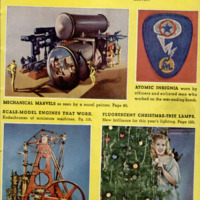 Popular Science Monthly, v. 147, n. 6, 1945
Popular Science Monthly, v. 147, n. 6, 1945

